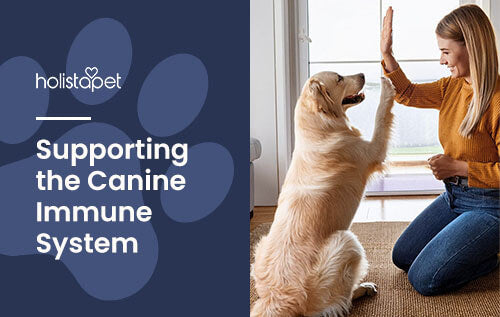Dogs dragging their rear ends on the floor can spark many questions. One very common is, "Can dogs get hemorrhoids?" While hemorrhoids are a familiar issue for humans, they're not typical in our furry friends.
This guide focuses on the facts about canine anal health and what might actually be causing your pup's discomfort. Let's investigate what's going on back there and how you can help your canine bestie feel better.
Can Dogs Get Hemorrhoids?
The short answer? Not really. Dogs don't get hemorrhoids like humans do, but they can experience similar symptoms caused by other conditions. Swollen veins and irritated tissue around a dog's anus are often mistaken for hemorrhoids but typically point to issues like anal gland problems or perianal fistulas.
Understanding the root of your dog's rear-end discomfort is key. If you see signs like boot scooting, excessive bum licking, or bloody stool, it's time to investigate further.
Understanding Hemorrhoids in Humans vs. Dogs
Humans develop hemorrhoids due to swollen blood vessels in the lower rectum. This is often caused by straining during bowel movements or prolonged sitting.
Our canine friends don't technically get dog hemorrhoids. In dogs, similar symptoms usually point to other issues, like anal sac problems or irritation in the rectal area.
Why Hemorrhoids Are Rare in Dogs
Hemorrhoids in dogs are rare because their anatomy doesn't set them up for this problem. Unlike humans, dogs naturally have a horizontal posture. This reduces the pressure on the blood vessels in the lower rectum.
Instead, what pet parents often notice are symptoms tied to conditions like impacted anal glands or perianal fistulas. These issues mimic hemorrhoid-like discomfort and irritation, but they stem from entirely different causes.
Common Causes of Anal Discomfort in Dogs

Anal discomfort in dogs can stem from various causes. Understanding them can help you get to the root cause of the issue:
- Anal Gland Issues. A dog's anal glands can become impacted or infected, causing swelling and irritation.
- Constipation. Straining due to hard stools can lead to discomfort and inflammation in the anal area.
- Perianal Fistulas. These painful sores or tunnels around the dog's anus often need medical intervention.
- Anal Polyps. These small growths on their rear end can cause bloody feces or painful defecation.
- Poor Muscle Tone. Weak muscles in the rectum area can lead to difficulties with bowel control or anal gland function.
- Dietary Issues. Poor nutrition or lack of fiber can contribute to bowel movement troubles.
Anal Gland Issues and Impactions
Problems in the anal glands are one of the most common causes of discomfort in dogs. These tiny scent glands near the anus can become impacted or infected, leading to swelling and irritation.
When glands don't express properly, they build up fluid, which causes your pup to feel itchy or even experience bloody stool. Signs to watch for include your dog dragging their rear on the floor or frequently licking the anal area.
Constipation and Straining
Constipation in dogs can cause significant discomfort, especially when they strain during bowel movements. Hard stools or a lack of fiber in a dog's diet often lead to this issue.
Straining puts pressure on the rectum, resulting in enlarged veins or irritation. Look for signs like fewer stools, straining to go, or visible discomfort.
Symptoms of Hemorrhoid-Like Conditions in Dogs
Dogs don't get hemorrhoids but can show comparable symptoms that signal other rear-end issues. Spotting these signs early can help you identify the underlying cause of your pup's discomfort. Let's take a closer look at the physical and behavioral symptoms to watch for.
Physical Signs To Watch For
Sometimes, your dog's body does the talking. Knowing these physical signs can help you act quickly:
- Scooting on the Floor. A telltale sign of irritation or issues with the anal sacs or glands.
- Swelling Around the Anus. Look for redness or swelling of the blood vessels around the anal area.
- Bloody Feces. An alarming symptom that could indicate anal polyps or more severe issues.
- Visible Growths. Small growths, benign tumors, or anal masses need veterinary attention.
- Frequent Licking. Too much licking near the rear end suggests discomfort or irritation.
Behavioral Changes Indicating Discomfort

When something's wrong, dogs often show it through behavioral changes. Paying attention to these signals can help you catch problems early:
- Excessive Licking. Persistent licking near the anal area is a common sign of irritation.
- Restlessness. Your dog may seem unable to sit still or lie down comfortably.
- Scooting on the Floor. Dragging their bottom along the floor often indicates itching or pressure.
- Whimpering or Crying. Vocalization can signal significant discomfort that needs immediate veterinary attention.
- Reluctance to Play or Move. Discomfort might make your pup withdraw from their usual activities.
Hemorrhoids vs. Swollen Anal Glands
At first glance, hemorrhoids and swollen anal glands may seem similar, but they're entirely different conditions. Understanding their differences helps pet parents pinpoint the cause of their dog's uneasiness and seek the appropriate course of action. Let's break down the specifics in the next sections.
Key Differences Between Hemorrhoids and Anal Gland Problems
Both conditions can cause irritation, but the underlying causes and treatments differ significantly. Here are their key differences:
- Cause. Hemorrhoids result from enlarged veins in the lowermost rectum area, while problems with the anal glands stem from impacted or infected anal sacs.
- Symptoms. Hemorrhoids cause bloody feces and discomfort, whereas anal gland-related problems often lead to persistent licking and scooting.
- Treatment. Hemorrhoids require remedies to reduce swelling, while anal gland issues may need expression or even surgical removal.
- Prevalence in Dogs. Hemorrhoids are rare in dogs, but anal gland troubles are quite common, especially in certain breeds.
How To Recognize Anal Gland Issues
Identifying issues with a dog's anal glands early can save them from unnecessary discomfort. These problems often have distinct signs:
- Scooting or Dragging. Your dog dragging their rear end on the floor clearly signals discomfort.
- Foul Odor. A strong, unpleasant smell from the anal area often indicates full or infected glands.
- Swelling Near the Anus. Visible puffiness around the rectal glands can suggest impacted anal sacs.
- Frequent Licking. Constant attention to the back area is a typical response to irritation or pain.
How to Comfort a Dog With Hemorrhoids
CBD for Discomfort in Dogs

CBD (cannabidiol) is famous for its soothing effects, helping dogs find comfort during challenging times. For some natural support, check out HolistaPet's CBD for pets line. Our products come from premium, U.S.-grown hemp, vegan-friendly, third-party lab tested, and specifically crafted for dogs.
Choose from our CBD Soft Treats, Hard Treats, Oils, or Capsules to fit your pup's needs. Pet parents love the calming and soothing effects our CBD products provide, making discomfort seem to fade!
Home Remedies To Relieve Discomfort
Sometimes, simple remedies can make a big difference in your dog's comfort level. A few tried-and-true methods include:
- Warm Compress. Applying gentle warmth to the anal area can soothe irritation.
- Chilled Witch Hazel. Dab a small amount to reduce redness and provide relief.
- Increased Fiber. Add fiber to your dog's diet to support smoother bowel movements.
Related: Browse all Holistapet Dog Home Remedies
Dietary Adjustments for Easier Digestion
A balanced diet can work wonders for your dog's digestive system and overall comfort. Adding fiber-rich foods like pumpkin or sweet potato can promote smoother potty breaks and reduce straining.
Don't forget hydration! Plenty of fresh water helps keep things moving smoothly, too.
Importance of Regular Exercise
Regular exercise encourages healthy bowel movements and helps maintain a healthy weight, reducing strain on the anal area. A daily walk or play session can make a big difference in preventing discomfort and keeping your furry friend happy and healthy.
Related Post: How Much Exercise Does My Dog Need?
When To Consult a Veterinarian
Sometimes, home care isn't enough, and professional help is necessary. If your dog's discomfort persists or symptoms worsen, consult a veterinarian. They can pinpoint the underlying reason and recommend the best medical treatment to get your pup back to feeling their best.
Symptoms That Warrant Professional Attention
Certain signs mean it's time to get your vet involved. Watch out for these red flags:
- Bloody Feces. Persistent blood in your dog's stool could indicate something serious.
- Severe Swelling. Noticeable puffiness in the anal area or rectum protrudes.
- Excessive Scooting. Frequent scooting that doesn't improve with care.
- Reluctance to Defecate. Signs of painful defecation or straining repeatedly.
Preventing Anal Discomfort in Dogs
Prevention is always better than cure, especially when it comes to rear-end issues. By adopting a few proactive habits, you can keep your dog comfortable and healthy:
- Diet and Hydration Tips. Feed your dog a fiber-rich diet. Make sure they have access to plenty of fresh water to promote healthy digestion.
- Regular Maintenance. Routine checks and anal gland expression, either at home or by a vet, can prevent impactions and infections.
- Regular Potty Breaks. Some dogs will hold their stool until they're taken on a potty break. Holding it in for too long can potentially cause issues like hard, dry stools that take more straining than normal to pass. Allowing your dog to relieve itself 2-3 times a day should give them enough opportunity to pass stools when needed. Senior dogs may require more potty breaks than younger dogs.
Frequently Asked Questions About Dogs and Hemorrhoids
Curious about your dog's rear-end health? Let's tackle some of the most common questions about dog hemorrhoids and related issues to keep your pup happy and comfy.
Are Certain Breeds Prone to Anal Health Issues?
Yes, certain breeds like Boston Terriers and German Shepherds are more prone to anal gland-related problems due to their anatomy and genetics. Regular care and monitoring can help prevent discomfort in these breeds. Always keep an eye on your furry friend for any signs of trouble.
Can Anal Discomfort in Dogs Resolve on Its Own?
In mild cases, anal discomfort might resolve naturally, especially with proper care, like a balanced diet and hydration. However, persistent symptoms often need attention to prevent complications. When in doubt, consult your vet.







![Probiotics For Dogs [Soft Chews] - HolistaPet](http://www.holistapet.com/cdn/shop/files/Probiotic-Infographic-1_472d7a29-e30c-435a-9638-1365d8c3a9f9.jpg?v=1725384841&width=104)


























Leave a comment
All comments are moderated before being published.
This site is protected by hCaptcha and the hCaptcha Privacy Policy and Terms of Service apply.